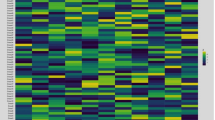Abstract
L. peruvianum var ‘humifusum’ is reproductively the most isolated of the species of the genusLycopersicon. It can be crossed with the cultivated tomato usingL. chilense as an intermediary. After a series of backcrosses of the three-genome hybrid F1 (L. esculentum ×L. chilense) ×L. peruvianum var ‘humifusum’ withL. esculentum, accompanied by selection for resistance to some economically important diseases, several lines were established. One of these lines, Cm 180, which showed resistance toClavibacter michiganensis subsp.michiganensis, was subjected to genetic analysis. This resistance was found to be controlled by a single dominant gene (Cm) that was not allelic to the gene originating fromL. hirsutum f.glabratum. ThisCm gene was genetically mapped on chromosome 4. The germ plasm ofL. peruvianum var ‘humifusum’ in combination withL. chilense was transferred intoL. esculentum. Different breeding lines possessing resistance to various diseases and pests could be developed from this material.
Similar content being viewed by others
References
Bogatzevska N (1988)Pseudomonas syringae pv. tomato the pathogen causing bacterial speck of tomatoes. Plant Sci 7:25 91–96
Botev A (1986) Evaluation of genusLycopersicon for breeding of resistance toFusarium oxysporum (Schlecht) f. sp.lycopersici (Sacc) Synd & Hans. PhD thesis, University of Plovdiv
Cirulli M (1974) Resistenza del pomodoro verso le malattie. Genet Agric 28:317–356
De Jong, Honma S (1976) Evaluation of screening techniques and determination of criteria for assessing resistance toCorynebacterium michiganense in tomato. Euphytica 25:405–414
De Jong, Honma S (1976) Inheritance of resistance toCorynebacterium michiganense in tomato. J Hered 67:79–84
Hassan AA, Strider DL, Konsler TL (1968) Application of cotyledonory symptoms in screening for resistance of tomato to bacterial canker and host range studied. Phytopathology 58:233–239
Heinz J (1972) Notice of release of bacterial canker resistant tomato breeding line H-2990. US Dep Agric Commun No.
Hogenboom NG (1979) Incompatibility and incongruity inLycopersicon. In: Hawkes JG, Lester RN, Skelding AD (eds) The biology and taxonomy of theSolanaceae. Academic Press, London, pp 435–444
Kuriyama T, Kuniyssu K (1974) Studies on the breeding of disease resistant tomato by interspecific hybridization. III. On the breeding of a new tomato line resistant to bacterial canker byCorynebacterium michiganense. Bull Ornamental Groups Res Sta Jpn Ser A 2:105–107
Laterrot H (1974) Value of the resistance of the tomato Bulgaria 12 toCorynebacterium michiganense (Smith) Jensen. In: Eucarpia tomato working group. Bari
Laterrot H, Rat B (1987) Stability of the resistance toCorynebacterium michiganense of the tomato line ‘Okitso Sozai 1-20’. In: Modern trends in tomato genetics and breeding (Eucarpia tomato working group). Salerno
Lindhout P (1987) Resistance againstCorynebacterium michiganense found inLycopersicon peruvianum. In: Modern trends in tomato genetics and breeding (Eucarpia tomato working group). Salerno
Lindhout P (1989) Investigation of tomato breeding for resistance toCorynebacterium michiganense. In: XII Eucarpia Congr. Göttingen
Rick CM (1963) Barriers to interbreeding inLycopersicon peruvianum. Evolution 17:216–232
Rick CM (1979) Biosystematic studies inLycopersicon and closely related species ofSolanum. In: Hawkes JG, Lester RN, Skelding AD (eds) The biology and taxonomy of the Solanaceae. Academic Press, London, pp 667–677
Rick CM, Lamm R (1955) Biosystematic studies on the status ofLycopersicon chilense. Am J Bot 44:663–675
Sotirova V, Beleva I. (1977) Resistance of wild species tomatoes toCorynebacterium michiganense (Smith) Jensen. Hortic Vitic Sci 14:63–71
Sotirova V, Beleva L (1978) Resistance of interspecific tomato hybrids toCorynebacterium michiganense (Smith) Jensen. In: Eucarpia of tomato working group. Leningrad
Sotirova V, Bogatzevska N (1988) New sources of resistance toPseudomonas syringae pv. tomato (Okabe) Young et al. CR Acad Bulg sci T 41:1541–1543
Sotirova V, Georgiev Chr (1981) Resistance of wild species of varying origins to White greenhouse fly (Trialeurodes vaporariorum West). Genet Plant Breed 14:372–378
Stamova L (1987) Breeding of resistance in tomato (Lycopersicon esculentum Mill.). PhD thesis, University of Plovdiv
Stevens WL (1939) Tables of the recombination fraction estimated from the product ratio. J Genet 39:171–180
Thyr BD (1969) Additional sources of resistance to Bacterial canker of tomato. Plant Dis Rep 53:234–237
Thyr BD (1976) Inheritance of resistance toCorynebacterium michiganense in tomato. Phytopathology 66:1116–1119
Vito M, Lamberti F (1978) Resistance of tomato varieties and hybrids to italian population ofMeloidogyne incognita. In: Eucarpia of tomato working group. Leningrad
Author information
Authors and Affiliations
Additional information
Communicated by M. Koornneef
Rights and permissions
About this article
Cite this article
Vulkova, Z.V., Sotirova, V.G. Study of the three-genome hybridLycopersicon esculentum Mill. —L. chilense Dun. —L. peruvianum var ‘humifusum’ Mill. and its use as a source for resistance. Theoret. Appl. Genetics 87, 337–342 (1993). https://doi.org/10.1007/BF01184920
Received:
Accepted:
Issue Date:
DOI: https://doi.org/10.1007/BF01184920




